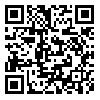Fri, Jul 4, 2025
[Archive]
Volume 11, Issue 3 (Summer- In Press 2025)
JCCNC 2025, 11(3): 0-0 |
Back to browse issues page
Download citation:
BibTeX | RIS | EndNote | Medlars | ProCite | Reference Manager | RefWorks
Send citation to:



BibTeX | RIS | EndNote | Medlars | ProCite | Reference Manager | RefWorks
Send citation to:
Izadi-Avanji F S, Mohseni-Asl R, Gilasi H. Psychometric Properties of the Persian Version of the Social Health Scale for the Elderly. JCCNC 2025; 11 (3)
URL: http://jccnc.iums.ac.ir/article-1-705-en.html
URL: http://jccnc.iums.ac.ir/article-1-705-en.html
1- Department of Medical Surgical Nursing, school of nursing and midwifery, Kashan University of Medical Sciences, Kashan, Iran. , fs.izadi@gmail.com
2- Geriatric Nursing Student (MSc), Trauma Nursing Research Center, school of Nursing and Midwifery, Kashan University of Medical Sciences, Kashan, Iran.
3- Department of Epidemiology, Kashan University of Medical Sciences, Kashan, Iran.
2- Geriatric Nursing Student (MSc), Trauma Nursing Research Center, school of Nursing and Midwifery, Kashan University of Medical Sciences, Kashan, Iran.
3- Department of Epidemiology, Kashan University of Medical Sciences, Kashan, Iran.
Abstract: (58 Views)
Background: Changes in physical, economic, and social conditions during old age are inevitable. These changes can reduce the social health of older adults. The Social Health Scale for the Elderly (SHSE) is a specific tool for evaluating social health in older adults. This study aimed to evaluate the psychometric properties of the Persian version of the scale in an Iranian population.
Methods: This methodological study investigated the psychometric properties of the Persian version of SHSE in Iranian older adults residing in Ardabil city. A total of 200 older adults (60 years and older (were selected using a multi-stage random sampling. Construct validity was assessed through confirmatory factor analysis (CFA). Reliability was evaluated using Cronbach's alpha coefficient and intraclass correlation coefficient (ICC) by conducting test-retest reliability over a two-week interval. Data were analyzed using SPSS version 16 and EQS 6.1 software.
Results: The SHSE has previously been translated into Persian based on the Wild et al model, and in this study, psychometric testing was conducted on the translated version. The impact score of all of the items in the face validity assessment was higher than 1.5. The content validity ratio (CVR) assessment confirmed the relevance of the scale's items without necessitating any changes in content or item count. The scale-content validity index (S-CVI) was 0.94. Following confirmatory factor analysis (CFA), three items were removed, confirming a three-factor structure for the scale. Cronbach's alpha coefficient for the subscales of social support, social adjustment and perceived environment resources was α=0.92, α=0.77, and α=0.72, respectively. Additionally, the intra-class correlation coefficient was estimated at 0.79.
Conclusion: The Persian version of the SHSE with 22 items and 3 subscales is a valid and reliable tool for measuring the social health of older adults in Iranian society. The SHSE's three-factor structure aligns well with the multidimensional nature of social health. This validated tool can support healthcare providers, policymakers, and researchers in implementing strategies to enhance social health and overall well-being in older adults.
Methods: This methodological study investigated the psychometric properties of the Persian version of SHSE in Iranian older adults residing in Ardabil city. A total of 200 older adults (60 years and older (were selected using a multi-stage random sampling. Construct validity was assessed through confirmatory factor analysis (CFA). Reliability was evaluated using Cronbach's alpha coefficient and intraclass correlation coefficient (ICC) by conducting test-retest reliability over a two-week interval. Data were analyzed using SPSS version 16 and EQS 6.1 software.
Results: The SHSE has previously been translated into Persian based on the Wild et al model, and in this study, psychometric testing was conducted on the translated version. The impact score of all of the items in the face validity assessment was higher than 1.5. The content validity ratio (CVR) assessment confirmed the relevance of the scale's items without necessitating any changes in content or item count. The scale-content validity index (S-CVI) was 0.94. Following confirmatory factor analysis (CFA), three items were removed, confirming a three-factor structure for the scale. Cronbach's alpha coefficient for the subscales of social support, social adjustment and perceived environment resources was α=0.92, α=0.77, and α=0.72, respectively. Additionally, the intra-class correlation coefficient was estimated at 0.79.
Conclusion: The Persian version of the SHSE with 22 items and 3 subscales is a valid and reliable tool for measuring the social health of older adults in Iranian society. The SHSE's three-factor structure aligns well with the multidimensional nature of social health. This validated tool can support healthcare providers, policymakers, and researchers in implementing strategies to enhance social health and overall well-being in older adults.
Type of Study: Research |
Subject:
General
Received: 2024/11/4 | Accepted: 2025/02/2 | Published: 2025/08/18
Received: 2024/11/4 | Accepted: 2025/02/2 | Published: 2025/08/18
Send email to the article author
| Rights and permissions | |
 |
This work is licensed under a Creative Commons Attribution-NonCommercial 4.0 International License. |





